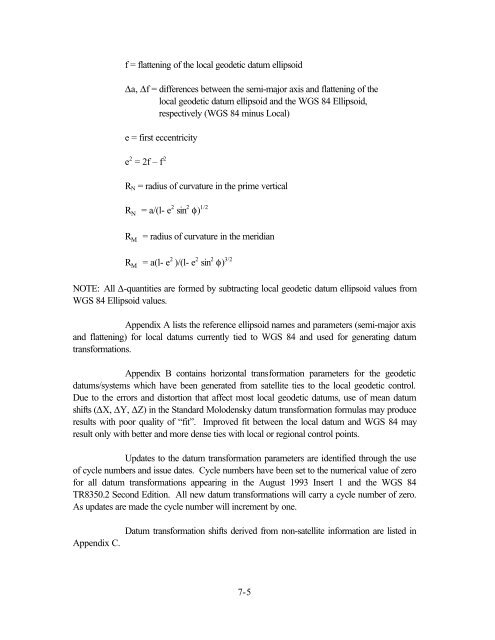WGS84RPT.tif:Corel PHOTO-PAINT - Henry A. Rowland Department ...
WGS84RPT.tif:Corel PHOTO-PAINT - Henry A. Rowland Department ...
WGS84RPT.tif:Corel PHOTO-PAINT - Henry A. Rowland Department ...
Create successful ePaper yourself
Turn your PDF publications into a flip-book with our unique Google optimized e-Paper software.
f = flattening of the local geodetic datum ellipsoid<br />
∆a, ∆f = differences between the semi-major axis and flattening of the<br />
local geodetic datum ellipsoid and the WGS 84 Ellipsoid,<br />
respectively (WGS 84 minus Local)<br />
e = first eccentricity<br />
e 2 = 2f – f 2<br />
R N = radius of curvature in the prime vertical<br />
R N = a/(l- e 2 sin 2 φ) 1/2<br />
R M = radius of curvature in the meridian<br />
R M = a(l- e 2 )/(l- e 2 sin 2 φ) 3/2<br />
NOTE: All ∆-quantities are formed by subtracting local geodetic datum ellipsoid values from<br />
WGS 84 Ellipsoid values.<br />
Appendix A lists the reference ellipsoid names and parameters (semi-major axis<br />
and flattening) for local datums currently tied to WGS 84 and used for generating datum<br />
transformations.<br />
Appendix B contains horizontal transformation parameters for the geodetic<br />
datums/systems which have been generated from satellite ties to the local geodetic control.<br />
Due to the errors and distortion that affect most local geodetic datums, use of mean datum<br />
shifts (∆X, ∆Y, ∆Z) in the Standard Molodensky datum transformation formulas may produce<br />
results with poor quality of “fit”. Improved fit between the local datum and WGS 84 may<br />
result only with better and more dense ties with local or regional control points.<br />
Updates to the datum transformation parameters are iden<strong>tif</strong>ied through the use<br />
of cycle numbers and issue dates. Cycle numbers have been set to the numerical value of zero<br />
for all datum transformations appearing in the August 1993 Insert 1 and the WGS 84<br />
TR8350.2 Second Edition. All new datum transformations will carry a cycle number of zero.<br />
As updates are made the cycle number will increment by one.<br />
Datum transformation shifts derived from non-satellite information are listed in<br />
Appendix C.<br />
7-5
















